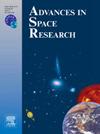Geomorphological and mineralogical analysis of the lunar Robertson crater
IF 2.8
3区 地球科学
Q2 ASTRONOMY & ASTROPHYSICS
引用次数: 0
Abstract
This study provides a comprehensive overview of the lunar Robertson crater of Copernican period located on the far side of the moon using multi-sensor satellite observations from combined Chandrayaan-I M3, LROC WAC Global Geomorphology and SELENE DTM mosaics. The analysis shows development of dynamic features, distribution of minerals, and topographic features during the crater formation. The crater preserves a complex geological evolution based on the mineralogical heterogeneity and distinct geomorphological features (such as accumulated melt flow at the crater floor, topographic undulations etc.) observed in a radial symmetry, which suggest formation through high energy impact processes. The detailed investigation of melt pool topography at the crater floor, highlights the formation and subsequent modifications of the transient cavity developed during simple to complex crater transition after the impact. The mineral species identified using the RELAB spectral library through the ‘spectral hourglass’ workflow show a distinct distribution, with Mg-spinel and olivine-rich lithologies concentrated in the central peak, while pyroxenes dominate the crater floor and surrounding rock rings. This pattern shows a complex mineral distribution, likely excavated from different depths as a result of the impact event. The dynamics of crater formation show a diameter respectively of 4.36 km and 5.73 km, assumed for chondrite and iron projectiles. Besides, CSFD measurements represent an absolute age of about 82 ± 4 Ma based on the 121 isochron fits to the differential data of post-impact craters that suggests recent resurfacing consistent with melt flow during the terminal stages of impact dynamics.
月球罗伯逊陨石坑的地貌和矿物学分析
本研究利用chandrayaan - 1 M3、LROC WAC Global Geomorphology和SELENE DTM马赛克组合的多传感器卫星观测数据,对月球背面哥白尼时期的Robertson陨石坑进行了全面的概述。分析了陨石坑形成过程中的动力特征、矿物分布和地形特征。陨石坑保存了一个复杂的地质演化,基于矿物学的非均质性和独特的地貌特征(如陨石坑底部积聚的熔体流动,地形起伏等),在径向对称中观察到,这表明通过高能撞击过程形成。对陨石坑底部熔池地形的详细调查,突出了撞击后从简单到复杂的陨石坑转变过程中形成的瞬态空洞的形成和随后的变化。通过“光谱沙漏”工作流使用RELAB光谱库识别的矿物种类显示出明显的分布,镁尖晶石和富含橄榄石的岩性集中在中央峰,而辉石则主导着陨石坑底部和周围的岩石环。这种模式显示了一个复杂的矿物分布,可能是由于撞击事件从不同的深度挖掘出来的。陨石坑形成的动力学显示直径分别为4.36公里和5.73公里,假设为球粒陨石和铁弹。此外,基于121等时线对撞击后陨石坑差异数据的拟合,CSFD测量结果显示撞击后陨石坑的绝对年龄约为82±4 Ma,这表明在撞击动力学的最后阶段,最近的重新表面与熔体流动一致。
本文章由计算机程序翻译,如有差异,请以英文原文为准。
求助全文
约1分钟内获得全文
求助全文
来源期刊

Advances in Space Research
地学天文-地球科学综合
CiteScore
5.20
自引率
11.50%
发文量
800
审稿时长
5.8 months
期刊介绍:
The COSPAR publication Advances in Space Research (ASR) is an open journal covering all areas of space research including: space studies of the Earth''s surface, meteorology, climate, the Earth-Moon system, planets and small bodies of the solar system, upper atmospheres, ionospheres and magnetospheres of the Earth and planets including reference atmospheres, space plasmas in the solar system, astrophysics from space, materials sciences in space, fundamental physics in space, space debris, space weather, Earth observations of space phenomena, etc.
NB: Please note that manuscripts related to life sciences as related to space are no more accepted for submission to Advances in Space Research. Such manuscripts should now be submitted to the new COSPAR Journal Life Sciences in Space Research (LSSR).
All submissions are reviewed by two scientists in the field. COSPAR is an interdisciplinary scientific organization concerned with the progress of space research on an international scale. Operating under the rules of ICSU, COSPAR ignores political considerations and considers all questions solely from the scientific viewpoint.
 求助内容:
求助内容: 应助结果提醒方式:
应助结果提醒方式:


